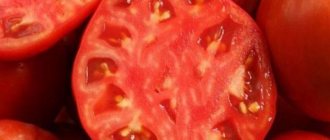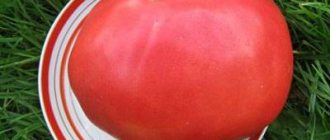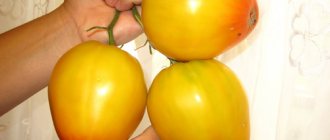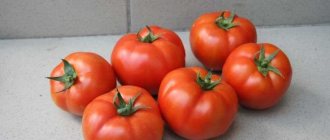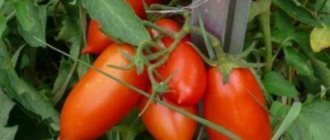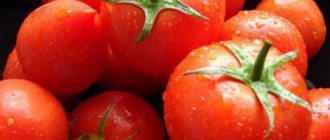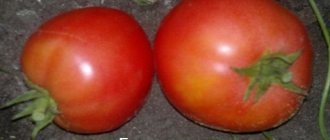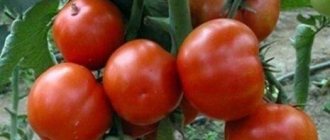Choosing a tomato variety to grow from seeds in the country is not an easy task, the solution of which directly affects the future harvest. We offer you a description of the hybrid tomato variety debut f1, as well as reviews from gardeners who grew it. The tomatoes grown by Dutch breeders are early ripening, so you can be the first to try the fruit this season.
Also read: Tomato Lyubasha, reviews of those who planted
Tomato “Debut” F1: description of the variety
| Variety name | Debut |
| general description | Early maturing determinate hybrid |
| Originator | Russia |
| Ripening period | 88-92 days |
| Form | Round |
| Color | Red |
| Average weight of tomatoes | 180-250 grams |
| Application | Universal |
| Productivity of the variety | 18.5-20 kg per sq.m. |
| Features of cultivation | Standard agricultural technology |
| Disease resistance | Resistant to major diseases |
The bush of a determinate type plant reaches a height of 60-65, when grown in a greenhouse up to 75 centimeters. A hybrid with very early ripening and an extended fruiting period. From planting seeds for seedlings to harvesting the first ripening tomatoes, the period will be 88-92 days . Debut F1 tomatoes are recommended for cultivation both in open ground and in greenhouses.
The tomato bush is not too powerful; it shows better yield when formed into two stems. Average number of thin leaves, green in color, the usual shape for a tomato, slightly corrugated. It is not recommended to intensively feed bushes. This leads to the creation of excess green mass of stems and leaves, which delays the onset of fruiting. According to reviews from gardeners, it is recommended to tie the bush so that ripening tomatoes do not lie on the ground.
Ultra-early ripening allows gardeners to avoid fruit damage from late blight. The harvest is harvested even before fruit damage begins. The hybrid is resistant to verticillium, fusarium and Alternaria stem cancer. According to breeders, resistance to leaf spot (gray) is high. Many gardeners note resistance to temperature changes.
Transplanting seedlings
The seedlings are transplanted 50-55 days after seed germination, when at least 5-6 leaves appear on it.
Typically, seedlings are transplanted in April - the first half of May (for a greenhouse) and the last third of spring (for open ground), when the ground warms up to 10-15 ° C to a depth of about 10 cm.
The best predecessors for tomatoes are beans, beets, and carrots.
For planting Debut-F1, nutritious, loose soil with a high proportion of turf content, with good moisture absorption and breathability and neutral acidity is suitable.
The most suitable place is a sunny area. The beds are prepared in advance by adding a mixture of humus (4-5 kg), superphosphate (30 g), wood ash (200 g) per m².
Scheme:
- 8-10 days before the planned date of transplanting the seedlings, they begin to harden them, taking them to a cool place;
- holes are dug to a depth of about 15 cm, a layer of humus or other organic matter 10 cm thick is laid on the bottom;
- the optimal distance between bushes is 0.4-0.5 m, between rows - 0.5-0.7 m with an average number of up to 7 plants per 1 m².
- For 10-14 days from the moment of planting, the sprouts are covered with plastic film for protection, especially in unstable weather conditions with the risk of return frosts.
The transplanted seedlings are watered 1 liter under each bush and sprinkled with soil after the final absorption of water, the root zone is mulched.
To avoid breaking off the shoots, install support pegs to which the tomatoes are tied. It is better to tie the garter to the supports before watering, because... in the absence of moisture in plant tissues, the turgor of the stems is reduced, which reduces the risk of their breakage.
Characteristics
- Small compact bush.
- Ultra early ripening.
- The versatility of fruit use.
- Resistance to tomato diseases.
- Good safety during transportation.
The only disadvantage noted is the need to tie up the bush.
Fruit:
- Round, smooth fruits with a small depression at the stalk.
- Unripe fruits are light green, ripened fruits are well-defined red.
- Average weight 180-220, with good care up to 250 grams.
- Universal use, do not crack when pickling whole tomatoes, good taste in purees, salads, lecho.
- The average yield is about 4.2-4.5 kilograms per bush, 18.5-20.0 per square meter when planting 7-8 plants on it.
- Excellent presentation, high safety during transportation.
You can compare the weight of the variety’s fruits and its yield with other varieties in the tables below:
| Variety name | Fruit weight |
| Debut | 180-250 grams |
| Rio Grande | 100-115 grams |
| Sugar cream | 20-25 grams |
| Orange Russian 117 | 280 grams |
| Tamara | 300-600 grams |
| Wild Rose | 300-350 grams |
| Spasskaya Tower | 200-500 grams |
| Newbie pink | 120-200 grams |
| Thick cheeks | 160-210 grams |
| Honey Drop | 10-30 grams |
| Variety name | Productivity |
| Debut | 18.5-20 kg per sq.m. |
| Rocket | 6.5 kg per square meter |
| Russian size | 7-8 kg per square meter |
| Yablonka Russia | 3-5 kg per bush |
| Valentina | 10-12 kg per square meter |
| Kate | 15 kg per square meter |
| Long Keeper | 4-6 kg per bush |
| Raspberry ringing | 18 kg per square meter |
| Grandma's gift | 6 kg per square meter |
| Brawler | 9 kg per bush |
Read on our website how to properly grow large tomatoes, along with cucumbers, along with peppers, and how to grow good seedlings for this. And also methods for growing tomatoes in two roots, in bags, without picking, in peat tablets.
Advantages and disadvantages
| pros | Minuses |
|
|
Photo
We invite you to familiarize yourself with the fruits of the “Debut” tomato variety in the photo:
Features of cultivation
The time for planting seeds for seedlings is chosen based on the weather conditions of the region. In this case, it is necessary to take into account the early maturity of the variety. The most optimal time for the middle zone is mid-April. At the stage of 3-4 leaves, seedlings need to be picked, combined with fertilizing with complex fertilizer.
After planting in the greenhouse, care consists of watering with warm water, removing weeds, and loosening the soil in the holes. 60-62 days after planting the seedlings, you will receive the first fresh tomatoes of the Debut F1 variety.
With good care, regardless of where the plants are grown, the hybrid tomato variety Debut F1 will give you an excellent harvest of large-fruited tomatoes with excellent taste and attractive appearance.
Tomato casta. DIY tomato paste - recipe without sterilization
There are many ways to make tomato paste at home. I suggest you take note of this simple recipe if you have a manual juicer (but not an electric one, or use a special juice attachment for a meat grinder) in your household. If there is no such device, then proceed to the next step-by-step description, a meat grinder is involved. It turns out to be as delicious as in the store, only much cooler.
Usually in all recipes, in order to prepare tomato paste and make it thick, you need to boil the ground tomatoes for a long time. With this technology you don't have to do this. Let's cheat a little.
We will need:
- juicy and ripe tomatoes
- salt to taste if you like
Stages:
1. Take a manual juicer and squeeze the tomato slices through it. Put the cake aside, it won’t be useful.
Source
2. Then place the entire required mass in a thick bag, which you place on a wire rack through which the water will separate and drip into any container or sink. You can hang the bag, just like in the previous version. And under its weight, the liquid will separate faster.
3. Then transfer the resulting thick porridge into a saucepan and boil the tomatoes for 5-10 minutes.
4. Don’t forget that the heat needs to be set to medium or low and stir constantly so that nothing sticks.
Next, place in sterile containers and secure with metal lids for long-term storage, and into the cellar or closet after complete cooling. Happy discoveries!
Useful video
We invite you to familiarize yourself with the basic rules for growing tomatoes in greenhouses. When growing the “Debut” variety, it will be very useful:
| Mid-season | Mid-early | Late ripening |
| Anastasia | Budenovka | Premier |
| Raspberry wine | Mystery of nature | Grapefruit |
| Royal gift | Pink King | De Barao the Giant |
| Malachite Box | Cardinal | De Barao |
| Pink heart | Babushkino | Yusupovsky |
| Cypress | Lev Tolstoy | Altaic |
| Giant raspberry | Danko | Rocket |
If you find an error, please select a piece of text and press Ctrl+Enter.
Diseases and pests
Ultra-early fruit ripening provides relative resistance to a number of diseases, incl. late blight, tobacco mosaic, fusarium, verticellosis and alternaria.
The hybrid is at risk for the spread of gray spot. For prevention purposes and when primary signs of infectious diseases are detected, tomato bushes are sprayed with fungicidal preparations.
It is recommended to spray against infections three times during the growing season.
Tomatoes are affected by the Colorado potato beetle, whitefly, aphids, and spider mites. Insecticidal treatments are used against harmful insects.
As an additional measure, folk techniques are used, treating vegetable crops with infusions based on herbs and seasonings.
